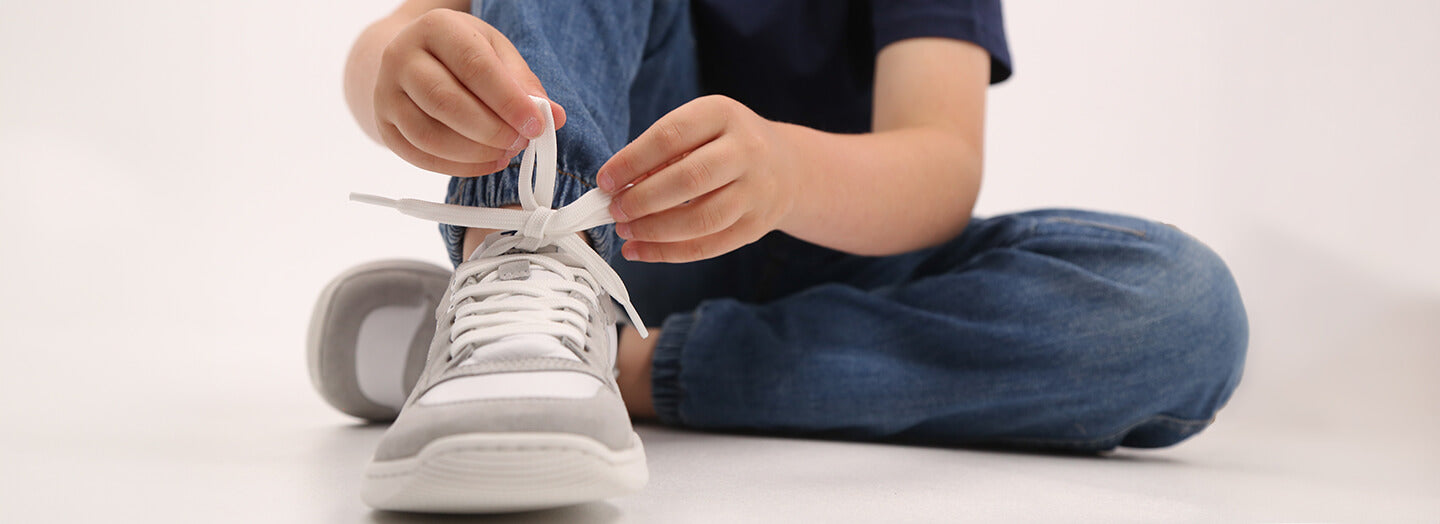Few things cause as much frustration in children as trying to do something they aren't yet ready for... while the adult world demands speed.
Imagine a 4-year-old sitting on the porch of his house, backpack on, bare feet, and forehead furrowed in concentration. In front of him are shoelaces that won't budge. They're slipping away. They're getting tangled up.
And an adult voice in the distance says the same phrase every morning:
“Come on, we’re leaving, put on your shoes!”

For decades, children's footwear design has been driven by an adult-centric logic: made by adults, with adult expectations, for bodies and brains that are not yet adults.
And as children grow, the market continues to offer shoes tailored to adults, requiring skills that are still developing.
Do you want to know why it's better to make shoes easier until certain ages?
Keep reading, because behind that choice lies a different way of supporting her independence… as much as possible.
Have you ever wondered what skills a child needs to tie their shoelaces?
The action of tying shoelaces integrates multiple neurological and motor functions , which do not all develop at the same time:
🧠 Sequential cognitive development : remembering and following several steps in order (crossing, tightening, looping, wrapping, pulling, etc.).
✋ Bimanual coordination : both hands have to work together, but making different movements.
🧩 Fine motor skills : requires precise finger control to grasp, squeeze, and manipulate the cord.
👁️ Eye-hand coordination : looking at what you are doing and guiding your hands accordingly.
According to studies on child development, these skills typically mature between ages 5 and 7 , although there can be considerable variability. Some children achieve this earlier, others later... and it's all perfectly normal .
🗝️ The important thing isn't the age, but being able to observe when your little one has the necessary skills to do it.
That's why we don't offer tie-able laces up to size 38 for children.
It's not a coincidence; it's a decision born of careful observation, listening, and calm reflection.
After seeing how much frustration a task like tying their shoelaces can cause in children—when they're not yet ready—we wonder:
How can we encourage their independence without demanding a skill they are still developing?

The answer was clear: offer them a system that allows them to put on their shoes alone, without help, without anger and without feeling incapable .
👉 That's why we offer Velcro closures and elastic laces up to size 38.
Because if we really want the child to be independent, it is preferable to offer them actions that they can perform on their own , and reserve the more complex learning for quieter moments, without the pressure of having to rush off to school.
When an everyday action becomes too demanding, the result is not learning, but rather: continued dependence on adults, loss of self-confidence, or frustration that accumulates every morning.
And autonomy is not built from there.
🧠 “And in this way, we won’t be depriving him of the opportunity to learn?”
Quite the opposite!
Tying shoelaces is a useful, fun, and symbolic skill. Many children feel proud when they manage to do it on their own. But that moment must come as true achievements come: with enthusiasm, curiosity, and play.
When you learn from desire, you don't need to remind yourself, force yourself, or repeat it a hundred times .
And to accompany this pressure-free learning, we've prepared something very special...
🎉 “Put on your Feroz shoes”: a pressure-free activity to play and practice
We've created a cutout so kids can make their own Feroz shoe out of cardboard , decorate it however they want, and use a real shoelace to practice tying knots.
🖍️ What do you need?

The cutout (download it here 👉 )
- Printable cardstock (the thicker the better 💪)
- A pair of scissors
- A hole punch or awl to pierce the holes in the cord
- Any cord you have at home
And eager to explore! 🧠👐
No rush. No pressure. Just play, discovery, and fun. Ideal for children from age 4 or 5, when their fingers are already beginning to gain dexterity, but without expecting perfect performance or "going out."
🦊 And if you come to Ferozland… you can order it there too!
We have the activity die-cut, ready to assemble , with everything you need to get started.
We don't want anyone to be left without their Feroz cardboard shoe! 💛
👟And what do we do with the… “I want shoes when I grow up”?
There comes a time when little ones look up to mom and dad with admiration and it is very clear to them:
“I want to be older too!”

They are fascinated by how they are tied, how they are adjusted, how they are transformed into a gesture that seems to say: “I can do it myself now.”
And of course, they also want those shoes when they grow up.
And although it is wonderful that they want to be like those they admire ❤️, it is important to accompany that desire with a realistic look at their real needs .
Because if we stop for a moment to observe what their days are like, we will see that:
They run, climb, take off their shoes in the car, on the couch, in the park... and put them back on in seconds.
They live in constant motion, with changes in rhythm, interruptions, and a lot of autonomy at stake.
And in that supersonic rhythm, shoelaces that come untied several times a day cut off their play, exploration and fun .
Therefore, even if they want to look like adults, until the age of 8 or 10 it is still more practical (and advisable) to use Velcro or elastic laces for everyday use .
Not because they can't learn, but because in their real lives there are more important things than tying and untying a bow fifteen times ⏱️ .
Now… we know that children's curiosity is unstoppable .
And if after explaining it to them, they still have that desire to wear laces “when they're older”... the ideal thing is to let them try them 🧪.
Give them the opportunity to experiment for themselves. Because usually, after a couple of days of constantly unraveling laces, interrupted runs, and impossible knots...
They realize on their own that elastic bands are cooler 😄.
The day they can make the bow and keep it tied... will come.
But in the meantime, don't let your childhood slip away in knots 🧒💨.

In summary:
✅ Tying shoelaces requires more than intention: it requires neurological development, coordination, and emotional maturity.
✅ There's no exact age. There's just a right time .
✅ Real autonomy is built on what they can do on their own , not on what it costs them each day.
✅ Forcing things before their time only creates dependency or frustration.
✅ Facilitating the fit means giving them tools to feel capable , not preventing them from learning.
✨ Because growing up confidently isn't about doing everything alone, but rather feeling that what I can do... I can do it myself .






